
Index
Iron Making Along The Canal
By Bob Schmidt
Southern Indiana is noted for its rich deposits of high quality coal. During canal times the
following article in the Evansville Daily Journal suggested that the coal found in the bed of the Wabash & Erie Canal be used to produce pig iron:
Evansville Daily Journal, Evansville, Indiana
June 9, 1859
An Important Experiment in Iron Making. —A committee of gentlemen in St. Louis have made a report of an experiment by the new process of manufacturing bar iron directly from the ore, with raw coal. The discovery promises to create a new era in the iron business. The committee watched the operations for 48 hours continuously, to satisfy themselves that there was no deception, and thoroughly to test the practical results. The coal and ore are first broken flat, weighed, and filled, in the proportion of 2½ pounds of ore to one of coal, into tubes which are subjected to a gradual heat for 48 hours, when the calcined contents of the tubes are let down into a “boiling furnace,” when the mass is worked into balls, then pressed into the “squeezer,” and rolled into muck bars at one beat. The committee say:
“We charged in pairs of tubes (32) with 11,869 pounds of crushed iron ore from the Iron Mountain, and 4,747 pounds of crushed Illinois coal, watching these for forty-eight continuous hours, when the ore being carbonized was let down (in pairs of tubes to a beat) and worked similarly to boiling. Weighing carefully the product of the identical tubes thus charged by us, we found the net yield to be one thousand six hundred and three (1,603) pounds of muck bar, or equal to fifty-one and forty-two hundredths (51,42-100) per cent of pure iron from the raw ore.”
The article then breaks down the cost of the items with the Gross Cost of $55.63.
The Committee adds: “We have made no allowance for wear and tear or contingencies, but have endeavored, as near as possible to get at the net cost—the gross cost would be about $25 per long ton of 2, 249 pounds, for muck bar, or $35 per ton of merchant bar—a price much less than the English bar can be made for at home, and certainly of a superior quality.
“We have had the bar iron cut up into small pieces for experimental tests. It shows for itself, and we have no hesitation in pronouncing it bar iron of a superior quality, which means neither cold short or red short.
“The facts and results as above detailed, and in every case, the result of close observation and of actual practical results, and justifies us in the conclusion that by this process Missouri is destined to lead the whole world in the manufacture of iron.”
The committee was composed of eight well known iron masters and foundry men, whose opinions will carry great weight wherever they are known. But we see no reason why they expect Missouri “to lead the whole world in the manufacture of iron.” Southern Illinois has ore as productive almost as that from the Iron Mountain, interstratified with her coal, and the iron can be valued for $1.50 per ton, and the coal furnished at 4 cents per bushel. This difference in the coast of ore and coal, taking the St. Louis experiment as a basis of calculation—would make a difference in favor of Southern Illinois of $18.60 in the production of 6,000 lbs. of iron, equal to 39 cents per 100 lbs, or $6 per short ton. If the mineral resources along the Saline river shall ever be developed, we think it will be difficult for Missouri to head the whole world in the manufacture of iron. But there are other regions about as favored as the banks of the Saline for the production of iron. The Wabash & Erie Canal between here [Evansville] and Terre Haute passes through a strata of the finest coal, over which is found the richest iron ores, the pigs from which now command the highest prices in the St. Louis market, in competition with their own boasted products from the Iron Mountain. Why can’t we, with our coal at 3 or 4 cents per bushel and iron ore by the side of it in abundance, lead even Missouri in the manufacture of iron?
She has to bring the coal and ore together from long distances, at a heavy charge of transportation. On our canal and railroad they lie side by side, and can be combined at half the cost in the process at St. Louis.
This important improvement in the production of iron must produce an immediate and vast change in the iron business. If bar iron can be produced at one or one and a quarter cents per pound, its uses will be infinitely multiplied and it will supersede wood in almost every form of structure; the demand for it will be indefinitely extended, and those regions that command the sources of its supply will find as abundant beds of wealth beneath their soil as have been found in the lands of California and Australia. The prosperity of the trade in this country must be alarming to the English manufacturer.
The above June 9th article in the Evansville Daily Journal suggests that Indiana might produce iron from ores by building foundries from Terre Haute to Evansville along the route of the Wabash & Erie Canal. The article is correct on the availability of good coal deposits, but the iron ore in this area is vastly inferior to the ore of Missouri. Iron Mountain, which is referred to in the article, is near Graniteville, Missouri in the Mark Twain National Forest, just south of St Louis.
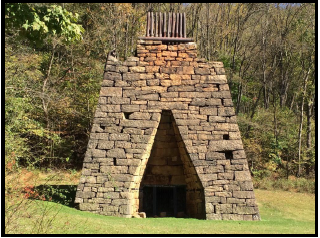
The picture of Eliza furnace and the picture below of Buena Vista furnace illustrate what an Indiana iron furnace might have looked like.

I (Bob Schmidt) am unaware of any other iron production that ever used the process described in the Evansville article. Generally, during the 1700s & 1800s, iron furnaces were largely found in the east such as Pennsylvania and there were some in southern Ohio. The furnace was stoked from the top with iron ore, charcoal and limestone. Once the furnace was fired the pig iron would be extracted from beneath the structure. Either coal or charcoal was used as fuel. To produce the charcoal required slowly burning vast amounts of timber in a nearby enclosed chamber. Once the trees in the surrounding area were consumed this fuel supply became a problem.
On the Wabash & Erie Canal near Antwerp, Ohio, the Black Swamp had an abundance of timber so iron furnaces were built there. However, the iron ore they used had to be brought in on canal boats to Northwest Ohio via the Great Lakes and later by rail.
There were some iron deposits in Martin and Greene counties in southern Indiana, but the ore was not nearly as iron rich or abundant as ore in other locations. Two furnaces in Indiana were the Randolph Ross Virginia Iron Works in Monroe County and the Andrew Downey Richland Furnace in Greene County.
The Richland furnace was built and went into service about 1841. The furnace stack was about 45 feet high and 9 feet across the boshes. Charcoal was used as fuel and about 9 tons of pig iron were produced daily. Some of the iron was made into hollow wares, stoves, machinery, etc. but most of the pig iron was marketed at Louisville, Kentucky. After 1851 pig iron could be shipped via canal boat down Richland Creek into the White River, through the White River lock at Newberry and then on the Wabash & Erie Canal to Evansville. Earlier steamboats were used on a river route along the White, Wabash and Ohio rivers. Another earlier route hauled the pig iron overland by wagon to Louisville. Later it was hauled overland just to Mitchell and then carried by rail to Louisville. Although the pig iron sold for about $26 per ton, transporting it cost $20 per ton making profit of pig iron production only marginal. The Richland furnace ended production in 1860 about the same time as the Wabash & Erie Canal was no longer used south of Worthington.
At one time Richland furnace employed about 100 men who settled in a small village called Furnace. These men were employed in three different activities. The first was to harvest
timber and haul it to a site to burn for charcoal. The second was to mine the iron ore from Plummer’s, Indian and Richland creeks and bring it, along with limestone, to the furnace. The third was manning the furnace itself to produce the pig iron. The town of Furnace was at one time larger than nearby Bloomfield. The town and furnace were located on Richland Creek. A flouring mill was also located at Furnace, which lasted longer than the iron furnace operation.
See Andrew Downing in the Biography section of our CSI Website indcanal.org. His biography appeared in the February 2007 issue of “The Hoosier Packet.”
In 1907 C.W. Shannon wrote, “The coming of iron manufacturers into the Indiana field should be encouraged. The reopening of ore deposits, the development of the coal fields, the building of furnaces within the state to smelt northern ores, the building of new railroads and the extension of others, and the aggressive policy of existing roads to encourage industries along their lines, will undoubtedly make Indiana a great producer of iron and other products of commerce that will later be developed.” Shannon’s comments were followed by U.S. Steel purchasing land at Indiana Harbor on Lake Michigan and the establishment of a new city of Gary, Indiana. The scale here was tremendously different than the two furnace companies established earlier in Indiana.
Sources:
“Canallers At Rest: Andrew Downing,” The Hoosier Packet, Canal Society of Indiana.
February 2007.
Bundy, William. “Iron Deposits in Southwestern Indiana,” Indiana Geological and Water
Survey/Indiana University, 1956.
“An Important Experiment in Iron Making.” Evansville Daily Journal 9 June 1859: 2.
Shannon, Charles W. “Iron Ores of Greene County,” Greene County, Indiana Genealogy Trails History Group, 2021.
William, Wayne. “Native Indiana Iron Ores and 19th Century Ironworks,” Indiana Geological and Water Survey/Indiana University, 1970.
Canal Notes
3 – A Lock is a Box
By Tom Castaldi
A lock in the Wabash & Erie Canal was like a box with water tight gates on each end for closing off the water, or opening up to let in the water.
Going up hill, a boat was floated into the box and the door was closed behind. Water from the up hill higher level would be let in. As the water filled up the lock, the boat rose to the higher level. The second gate was opened and the boat moved out at the up hill water level. Going down hill, just the opposite happened.
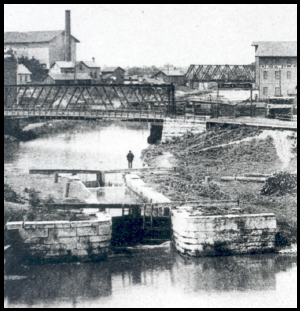
entering Swan Creek below Lock
at Toledo, Ohio
Lockkeepers did all the gate moving work by hand and for their efforts locks are remembered by their names. It took three locks to move a boat from the Indiana-Ohio line up to the town of Fort Wayne:
Saylor’s Lock No. 1 has disappeared from its old digs a few yards into Indiana and alongside Highway 24.
Gronauer’s Lock No. 2 had been buried and forgotten until work crews unearthed it in 1991 during construction of the I-469 access ramp to U. S. 24 East.
What’s left of Moots Lock No. 3 is under the railroad about a block east of Anthony Boulevard in Fort Wayne.
Today U.S. 24 took over the canal right-of-way from the State Line cutting through New Haven, but lies beneath the Conrail line through Fort Wayne. Here it reached its highest point, and after a second rise in the elevation near Terre Haute, Indiana, it was down hill all the way to the Ohio River.
Locks made the canal possible, but it took 73 of them to actually move boats up and down the 468-mile route of the finished Wabash & Erie Canal. (Toledo, OH to Evansville, IN)
Narrowboat Summer-A Book Review
THE NARROWBOAT SUMMER by Anne Youngson
Published 1-26-2021 by Flatiron Books
Reviewed by Cynthia Powers
Recently I found a book that CSI members might enjoy. I read it on my e-reader, which was a companion during COVID isolation.
The Narrowboat Summer is an account of how two women, tired of their previous lives, end up on an English canal boat, or narrowboat. Eve has just been laid off from her 30-year job. When she realizes she no longer can use her company car, she walks home along the towpath. There she meets Sally, who has walked away from her boring marriage and two adult children. Suddenly they hear disturbing howls from a dog confined in a moored canal boat. On investigating, they find he belongs to Anastasia, an eccentric lady who is facing a difficult course of medical tests and possible surgery, all with an uncertain prognosis. She needs to spend several months coping with all this, but can’t afford to pay for her boat to be docked for a long time. So Eve and Sally, despite having absolutely no experience, agree to live on the boat with Noah, the dog, touring the canals, and meet up with Anastasia later.
One of the first things they do is visit a charity shop for unconventional clothing to suit their new life, and Sally even gets pink highlights in her hair.
The narrowboat has a gasoline engine and bathroom and cooking facilities. Eve can bike to nearby villages for groceries. Most of their time and energy is spent going through locks and tunnels. At one point they even tackle a “flight” of 21 consecutive locks. They also play Scrabble, Eve discovers a new interest in cooking, and of course they meet many colorful characters along the way.
At the end of the summer, will the three decide to continue living on the canal, or will they figure out something else?
Early Sign Placed At Aqueduct No.5″
For the Canal Society of Indiana’s 40th anniversary we looked back into our archives and found articles that showed how individuals contributed to the society’s goals. In the 1985 Vol. 4 No. 1 of “Indiana Waterways,” the first journal of the society, we found an article entitled “Eel River Aqueduct No. 5 Now Marked Thanks to Hubert Leslie, Joe Kline.” It said that Hubert Leslie, who was a CSI director from Logansport, and Joe Kline, also from Logansport, deserved heartfelt gratitude and respect for their individual initiative and action in working independently and with their own means in marking the remains of the 200 foot Eel River
Aqueduct No. 5 of the Wabash and Erie Canal. It said to find the marker drive West on High Street until just before it makes a sharp left-hand curve at about Fourth Street. Turn right into a parking lot and drive across it to the alley that leads along the river bank to see the eastern abutment of the aqueduct.
We think that this was the first sign placed at the site. This sign was later replaced. One of CSI’s new signs has been erected there in 2019. This site will be seen on our CSI tour in August 2022.
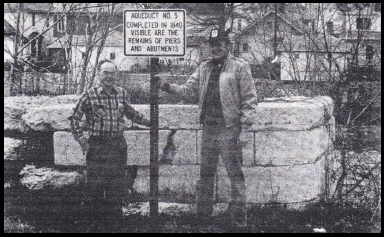
Hubert Leslie (r) at Aqueduct No. 5.

Below: The wall where the aqueduct’s north abutment was located has fallen in to the river.

Whitcomb On Extending The W & E Canal West
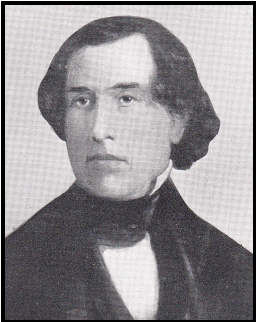

Evansville Journal, Evansville, Indiana
February 26, 1846
GOV. WHITCOMB AND THE LANDS FOR EXTENDING
THE WABASH & ERIE CANAL WEST OF THE TIPPECANOE.
The Sentinel assumes to Mr. Whitcomb all the credit of the recent arrangement with our bondholders, because when Commissioner of the General Land Office, he had advocated by strong argument, the right of the State to the lands for continuing the canal west of the Tippecanoe [river]. A brief statement of the facts will show to how much credit the Governor is entitled.
In 1827, Congress granted to Indiana lands, equal in quantity to one half of five sections in width, from one end to the other, for a canal to connect the waters of the Wabash with those of Lake Erie, at the points where there would be uninterrupted navigation.
Pursuant to this act, Mr. Stansbury, an engineer of the U. States, surveyed a route for the canal, extending from the falls of the Maumee to the Tippecanoe river on the Wabash. The State of Indiana this route relinquish to the State of Ohio the lands lying in it, to construct that part of the canal from the Indiana Line to the Falls of the Maumee.
The State of Ohio, after receiving these lands found that to obtain uninterrupted navigation to Lake Erie, the canal must be extended from the falls to the Maumee Bay. Under the original grant to Indiana, she extended it to this bay, and selected the alternate sections as allowed in that grant for that part of the canal located by Mr. Stansbury. This selection was confirmed by the Commissioner of the General Land Office.
When the State of Indiana projected her system of Internal Improvements, one part of them was to extend the Wabash and Erie canal to Terre Haute, from the Tippecanoe, for the navigation was found to be greatly interrupted above Terre Haute.
Mr. [Jesse] Williams, the engineer, in one of the meetings of the Board of Internal Improvements, suggested to it, that by the terms of the act of Congress in 1827, the State was entitled to extend the canal to Terre Haute, that being the highest uninterrupted navigable point of the Wabash, and to the alternate sections allowed by that act. He appraised the Board of the action of Ohio in extending her part of the canal. The board ordered its president, David H. Maxwell, aided by Mr. Williams, to prepare its views on this matter. The result was that our State, as did Ohio, extended the canal to Terre Haute and claimed the alternate sections. It sent to the General Land Office, Whitcomb then being Commissioner, to have this claim admitted.
Now what did Mr. Whitcomb do? Assume the responsibility as did the previous Commissioner, of deciding upon the validity of the claim! Not he—that would have been unlike Whitcomb. Under the pretense of delicacy of feeling because he was a citizen of Indiana, he referred the matter to Mr. Attorney General [Charles] Butler, who decided that the claim was good. Then Mr. Whitcomb expressed his opinion, and echoed the arguments of the Attorney General.—Bloomington Herald
Renegotiating Indiana’s Debt: The Butler Bill
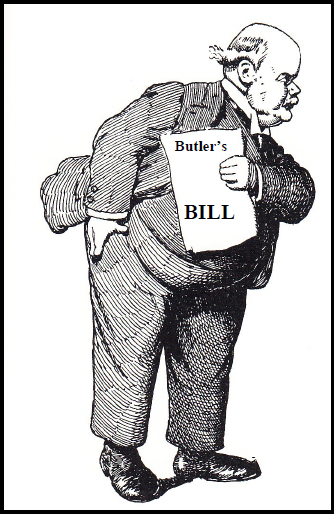
Indiana was unable to meet the payments for the debt used to fund the 1836 Mammoth Internal Improvement Bill. Charles Butler, an attorney from New York, was hired by the bondholders to come to Indiana, meet with the Legislature and settle the debt problem.
They must surrender their original bonds and fund $800,000 to complete the unfinished work on the W & E Canal to Evansville.
Then the debt was divided into two parts.
1. All of the existing canal properties and assets would be pledged to the bondholders and the
revenue from this completed canal would be used to repay interest and principal.
2. The other half of the debt would be paid by a tax levy on Indiana property owners.
The completed canal was to bring more settlers to Indiana. In theory this would add to the revenue of the canal and increase property ownership in the state. Therefore: both portions of the debt would be repaid with interest.
The following newspaper article explains how he was successful in achieving a renegotiation of the debt.
Evansville Journal, Evansville, Indiana
February 12, 1846
“We clip the following article upon the Public Debt Law, from the St. Joseph Valley Register, one of the ablest and most thorough Whig papers in Indiana—a paper whose editor, Schuyler Colfax, Esq., is as intimately acquainted with the political, pecuniary, and moral condition, resources and energies of the State as perhaps any other.
THE STATE DEBT
“The passage of the bill for the adjustment of the State Debt Interest, and the completion of Wabash and Erie Canal to Evansville on the Ohio River, has sent a thrill of joy through the heart of every sincere friend of the State—of every man who cared in the slightest degree for its Honor and Credit. The terms upon which the matter was finally adjusted are of the most
satisfactory character such as none but a repudiator can cavil at. They are easy and light beyond all previous hopes entertained by even the most sanguine friend of State Integrity. Let us look at them.
“Exclusive of the bonds that were issued and sold for the capital of the State Bank, and the principal and interest of which devolve on that Institution, the State Debt amounted to $11,090,000. The sum with the back interest unpaid for over four years, amounts now to $13,000,000. According to the Bill passed by the Legislature, our creditors are to take the Wabash and Erie Canal in its present state, with its assets in the shape of land and its liabilities in the shape of scrip, for One Half Of The Whole Debt, relieving the plighted fate of the State of that amount, and resting it entirely upon the receipts from the Canal for ultimate payment. They are also to finish the Canal to Evansville within 4 years, when this great work will connect the extreme North Eastern with extreme South Western portions of the State, and like some great artery in the human frame, strengthening and fertilizing the whole. When it is remembered that at present the tolls on the Canal do not really reimburse the State for its expenses for repairs, breakage &c. —and also that it would be utterly impossible for her unaided to complete it, the excellent terms of this part of the arrangement must be conceded.
“For the remaining half of the State Debt amounting to about $6,500,000 new bonds are to be issued, bearing 5 per cent interest, and the principal payable at the pleasure of the State. A State Tax 25 cents on the $100 being but 5 cents on the $100 (or 1/2 mill on the $1) heavier than it has been for several years past—and State Poll Tax of 75 cents will pay the annual interest
accruing thereon, and is, at any rate, all that in this arrangement our creditors require at our hands. Why, it will not, comparatively, be felt. In 1841the State levied a State Tax of 40 cents on the $100 over one half larger than the present one, but even that it levied and collected
annually, would not have paid our interest as our Debt then stood.
“Now, with a Tax less than two-thirds in amount what that one was, we not only pay all our interest, but if the taxable of the State increased each year, as it most likely will, we shall have annually a small surplus increasing with the increase in population and property to apply as a sinking fund towards the gradual redemption of the Principal.
“Really the change in our position as a State seems almost beyond belief. For 3 or 4 years past we have been paying State Taxes annually of 20 cents on the $100 and yet not liquidating a
dollar of our interest—Our State Faith remained dishonored, the name, Indiana, was becoming, in the minds of many (unjustly it is true, for it was our poverty and not our crime) a synonym for Repudiator. Now, with this liberal compromise, by which eventually our creditors will lose northing the State will gain much in Character, in Population, and in Wealth, — with only an increase of only a half mill tax on the dollar, which half our citizens would not feel if they did not know it, our State honor is redeemed— our plighted faith again becomes untarnished—and Indiana once more wheels into the ranks of debt-paying States, sacrificing less too in doing it, than any of her citizens had ever hoped for.
“But the proud consciousness that we feel now is not all the benefit that is to result from this change. True the fact that we are acting honorably—the reflection that no creditor can
sneeringly say to the State, Pay me what thou owest—the thought that no longer is the name of Indiana to be a bye-word and reproach—are all heart cheering indeed. Yet this is not all. This step again places our State on the high-road to prosperity and advancement. Immigrants will no longer shun her. The prospect of grinding, onerous taxation in a few years to pay heavy arrears of interest will deter none from settling within her confines. Those who hated to link their destinies and that of their families to a dishonored State will not as heretofore pass on future westward. But as immigration flows into our territory, peopling its solitudes, tilling its yet uncultivated lands and adding to the wealth and standing of the State in numbers, taxables and intelligence, the completion of the Wabash Canal will attract a double portion to the country adjacent to it to increase its population also. Thus with the step of honesty will Indiana advance till, at the second census from the last one, she will stand proudly Fourth on the list of States of the confederacy. Should we not rejoice?”
Although rejoicing at the passage of the Butler Bill seemed appropriate at the time, the end result was much different than expected. The canal failed and was sold. Bondholders were left with only minimum repayment.
Canallers Known As Fighters
Canallers were known to be a rough and tumble sort, drink a lot and entertain themselves with fisticuffs. To advertise their products as being strong and sturdy, Strauss used this drawing with the following information in an advertisement from around 1955:
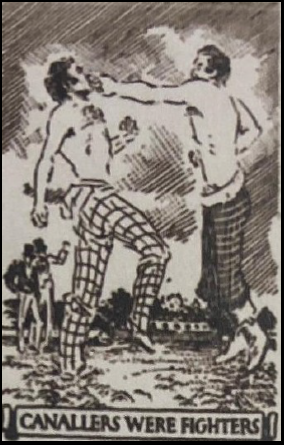
In the calm well ordered interiors of the Hickey Freeman Shops—in the smooth human efficiency of this great tailoring organization—there does not arise the ancient elemental urge to “fight it out with fists.” Pride in hand-work, begets a happy contented state.
Only over one situation does Hickey Freeman get fighting mad—when a man works so fast as to
jeopardize perfection. (Imagine that in this machine age.)
Better work per man—not more work per man—is the Hickey Freeman Law.
For instance a Hickey Freeman Tailor is only permitted to press 5½ sack coats per day—no more! But he
becomes an expert at that particular operation!
“For the finest tailored clothes (Ready-For-Wear) in the world”—Prices are reasonable.
STRAUSS
L. Strauss & Company
Note canal boat in the background.
This advertisement was found in the Fall 2021 issue of Traces magazine by Tom Castaldi
Side-Cut City
The Logansport Pharos-Tribune of Saturday, October 9, 2021, ran an article entitled “Indiana nature and a true love story” by Harold Allison. Besides talking about the natural beauty of the area around Williamsport, Indiana, the article says:
“Williamsport is said to have been named for a local property owner named William Harrison, not for the famous William Henry Harrison. It once had the unusual nickname of “Side Cut City.” This was given to Williamsport because, while not on the main route of the Wabash and Erie Canal it wanted to be part of the trade that came with this long waterway. Local merchants raised $16,000 to dig a spur from the canal to Williamsport and allow the boats to reach their out of the way settlement.”
The spur of the Wabash & Erie Canal was dug off the mainline canal just below Attica, Indiana to the Wabash River. Canal boats were lowered by a lock into the river and poled up river to the Williamsport landing, loaded or unloaded, and then poled back down river to enter the lock and side-cut to the mainline canal and then proceed either north or south.
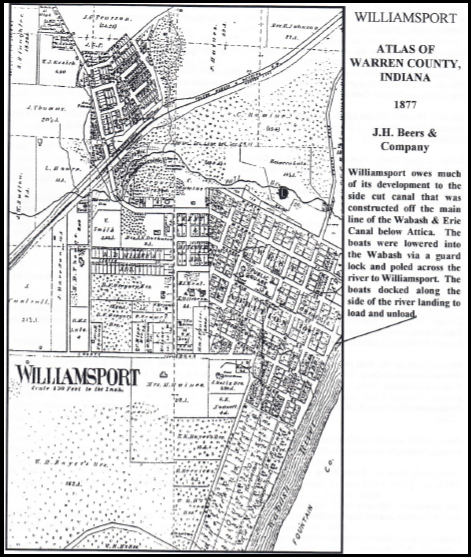
In 1848, Harrison and other citizens began talking about building a “side-cut” canal to enable Warren County producers to take their loads directly to the Wabash & Erie Canal. They
established the Williamsport Canal Lock Company. A subscription paper was started to raise the necessary money to finance the project. William Kent led the drive with $1000 and many others followed with amounts up in the hundreds. It took three years to plan and $16,000 in donations to dig and construct. It was done by a man named Barcus.
When the “side cut” canal was finished a celebration was held with a huge stall fed ox roast of which all residents for miles around were invited to attend and listen to the speeches of
congratulations. Shortly thereafter Williamsport had the biggest growth in its history and the town was incorporated in March 1854. However, Attica was more convenient and continued to draw the trade. The “side-cut” lost so much water at the river in the gravel deposits below the “Wide-water,” where the side cut entered the canal, that the side cut could not always carry boats.
The canal company was sued by Williamsport in the Fountain circuit court to supply more water to the side cut. The canal company was able to prove that they did not have enough water for the main canal let alone for the side cut. The Williamsport Side Cut’s locks rotted and nothing was repaired thus ending the usefulness of the side cut canal. Williamsport failed
rapidly and probably owes its existence today to the fact that it was the county seat for Warren county.
Kutz Lake
By Sam Ligget
There are no visible signs remaining of Kutz Lake (Kuntz Lake) today. It is possible to discern the location of the Wabash and Erie Canal though that was once covered by this lake. The south end of what was once the lake near Woodsmall Road is now farm land. The north end has become a tree row surrounding the old canal bed. Just to the south across Woodsmall Road is what is called the “Blue Hole,” a section of the Crosscut Canal still watered. To the north end of what was Kutz Lake is Riley, Indiana. Lock #49 was about .3 of a mile to the north of the of the dam that formed Kutz Lake. The lake would have been on the summit level of the Crosscut Canal. I searched through plat maps and atlases of the Vigo County, Indiana area and the latest I could find Kutz Lake listed on a map was 1950. Kutz Lake was also called Meighen Lake. The names are from the owners of the property at different times in history.
The following is titled Historic Marker-Kuntz Lake (Kutz Lake) located in Riley Township,
Vigo County, Indiana, and is reprinted here courtesy of the Vigo County Public Library, Terre Haute, Indiana:

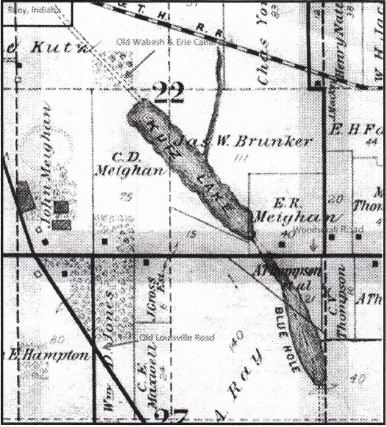
I contacted the County Clerk’s Office in an attempt to determine the issue involved in the
litigation in the spring of 1897. No record of any legal action involving the Riley Fishing Club could be found. It is possible that the case was settled out of court even through the sign says otherwise.
The Riley Utility Club rebuilt the dam in 1930 according to the historic marker. An article from the Indiana Writers Program Collection, Special Collections Dept., Indiana State
University reports that Lake Kutz had “fish of good size” to be caught in it and that it had been stocked by the State Fisheries Association. The author of this information was Isaac McIntosh of 1451 Barbour Ave., Terre Haute, Ind.
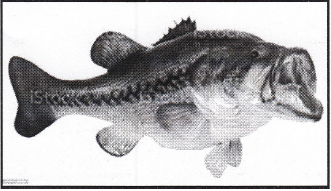
Lake Lutz, a body of water on the farm of Charles Meigham, was stocked with fish by the State Fisheries Association several years ago. Fish of good size are caught here, and if you are
inclined to try your luck you are allowed to do so if you have Mr. Meigham’s permission. The farm is one mile south of Riley on the Louisville Road.
From the Year Book of Indiana 1931 found in Visions and Voices is a list of all the waters, by county, that the state planted fish in. Nowhere in this writing is the word stocking used to describe putting fish in a body of water. Below is a portion of that list. Besides Lake Kutz I included in the list Old Erie Canal in Vigo County and the Old Canal in Gibson County. There may have been other watered sections of canals that were planted, but their names, like Kutz Lake, didn’t make it obvious it was part of the canal system in Indiana.

A legal notice in the April 2, 1952 of the Terre Haute Tribune was listed by T.H. 1st Nat’l Bank, Adm. of Charles D. Meighen estate by Wm. J. Tichenor, Trust Office: Winfield M. Fox, atty. The listing was to be sold Apr. 16, 1952, 10 a.m. at the bank. “All the part of the East half of the south West quarter of Sec. 22, T 11N, R 8 W, that lies southwest of The
Wabash and Erie Canal, 70 acres ± .” This transaction must have been the last of Lake Kutz or Meighen Lake as there is no mention of either in public records after this date.

In April of 1994 Canal Society of Indiana’s spring tour stopped at the “Blue Hole” mentioned in the above article. Photo by Bob Schmidt
New Projects For Great Lakes
The Hamilton, Ohio Journal-News reported in January that the Soo Locks project in Michigan was awarded $516.2 million to complete a new replacement lock and rehabilitate an existing lock and dam that will allow maritime ships access to Lake Superior from the rest of the Great Lakes system. Nearly $6 billion dollars worth of industrial and agricultural products (80 million tons) pass through these locks each year.
Another $225.8 million was awarded to the Brandon Road Lock and Dam project in Illinois to construct a dam and invest in technologies to stop Asian Carp, which harm native fish, from
spreading into the Great Lakes from local rivers. This should protect the $7 billion fishing and $16 billion recreational boating industries.
Spending $742 million of federal funds on these two U.S. Army Corps of Engineers’ projects will not only provide better passage through the lakes and protect native fish species, it will provides jobs and help the families of Middle Class workers and their communities.
Thanks to John Geyer, CSI member from Hamilton, Ohio for sending the article.
Delphi Receives Setting Poles
Shortly before St. Patrick’s Day the Canal Interpretive Center at Delphi, Indiana were given setting poles, potentially dating back to the Canal Era. These wooden poles, also called pike poles, measure about 10 feet and 18 feet long, and were found in a warehouse in Lafayette, Indiana. The Wabash & Erie Canal once passed near this warehouse.

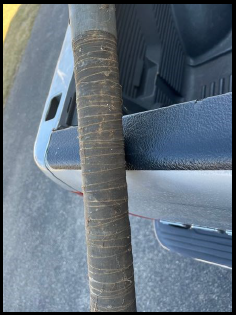
Setting poles were used to push a boat along by pressing them into the bottom of the waterway. Sometimes they had a conical iron tip and even a hook. They controlled the movement of a canal boat near a wharf or in a basin. Their use had to be restricted if the canal bottom was lined with clay puddle, as they could puncture it.
It would certainly be quite a workout, but those early travelers worked with what they had! Even today on Delphi’s replica canal boat, they use poles for steering and maneuvering in tight
spaces.
New Wifi Added To Canal Park
In March small gray panels and an antenna were added to roof of the Canal Interpretive Center in Delphi’s Canal Park. Guests now have free internet access in the Pioneer Village, the campground, and even as far as the rustic cabins, which can be reserved on AirBnB. Although the cabins have no electricity or running water, visitors will still be able to access the web!
While in Canal Park be sure to visit the Canal Museum, which has exhibits that explain the history of the Wabash & Erie Canal, how it was built, who built it, and the businesses it served in the 1800s.
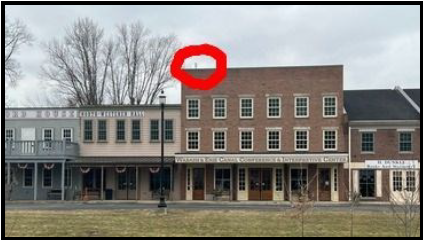
Carroll County Wabash & Erie Canal Announces 2022 Schedule

Come and join the fun!
Terre Haute Headquarters For W & E Canal
This photograph of the Headquarters for the Wabash & Erie Canal in Terre Haute, Indiana, was published by the Tribune-Star in its Saturday/Sunday, March 12-13, 2022 issue from the collection of the Vigo County History Center. It was forwarded by Jeff Koehler, a CSI director, from Center Point, Indiana. This photo was probably taken in the 1920s.
The Wabash & Erie Canal was managed by the State of Indiana out of Indianapolis until 1847 when the Canal Trust was established and moved to Terre Haute. The Trust had this building built as its headquarters in 1853 to house the offices of the Wabash & Erie Canal and serve as the home for its manager. It stood on Ohio street between Sixth and Seventh streets in Terre Haute. Many years later it was the home of George W. Bement and then became the office of the Terre Haute Auto Club. It was demolished in 1932.

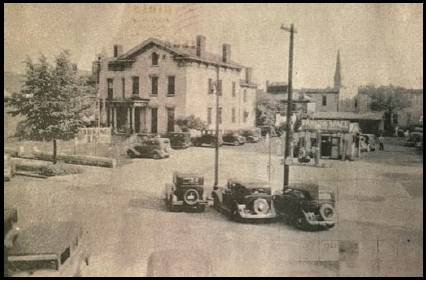
Third Flooding Of Depot In Gateway Park
Heavy rains in Metamora, Indiana, and flooding once again damaged the old historic depot in Gateway Park, which is owned by the Whitewater Canal Byway Association (WCBA) and serves as a meeting and banquet room. The Whitewater river has dramatically changed its course due to the Indiana Power Company having torn out all vegetation and trees along its banks for about 1/2 miles downstream from Gateway Park. About 35 to 40 acres of land right behind Gordon’s Lock on US Hwy 52 were lost as the river changed its course. With this change, Duck Creek that passes by Gateway Park on the east, now meets the river head-on and, in a heavy rain, the river dams up Duck Creek, which in turn inundates the campground area and historic depot in Gateway Park on its east side. All photos courtesy WCBA website.
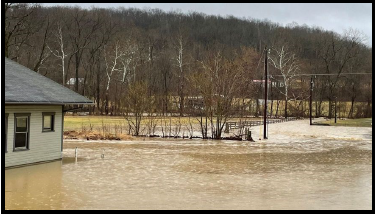
Franklin county received about 1.5”-2.0” of rain over Sunday night, March 6, and Monday morning flood waters began to subside . The “Depot” had six inches of water standing inside it with further damage done to the parking lot and campsites.
This is not the first time the “Depot” flooded. In 2019 it had 18 inches standing water inside it, which led to replacing the carpet, floor joists, drywall, insulation, furnaces and air conditioning units for over $35,000.
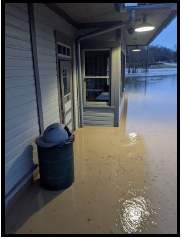
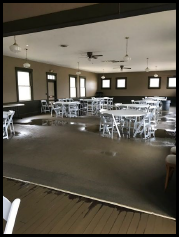
The current flood caused to wood floor to buckle and the building to be filled with silt. The carpet needs replacing as does some drywall and insulation. Luckily, when the new furnaces and air conditioners were installed in 2019 they were placed on platforms and were above the flood waters.
Clean-up began after the remediation team left. On Thursday March 10 volunteers washed walls, baseboards, tables and chairs and began scraping the dried silt from the tile floors in the kitchen. This was a good start but much more help was needed.
The campground was covered with debris. The driveway was covered with so much sand it looked like a beach. Since most of WCBA fund’s to maintain the park come from campground rentals there is concern that it won’t be ready for spring rentals.
Fundraisers are being planned. Donations may be made to WCBA, 19067 U.S. 52, Metamora, IN 47024
Welcome New Members
The Canal Society of Indiana welcomes the following new members who have joined at the
single/family rate of $20 unless otherwise noted or who have been given gift memberships:
Larry Bracken Anderson, IN Gift of Thomas Grimes
Bill Titus Fishers, IN
Canal Clippings From Old Newspapers
Evansville Daily Journal, Evansville, Indiana
June 13, 1859
The Account of the Managers of the Canal. — The Managers’ account of the expenditures for the [Wabash & Erie] canal, as rendered to the Trustees, and published by Mr. Raleigh in
Saturday’s Journal, may require—in order to have the matter fully understood by the subscribers—the following explanation. In the first place, it should be distinctly remembered that all moneys collected, either from tolls or the contributions from the subscribers to the Canal fund, goes into banks to the credit of the Trustees, and not a dollar of it can be used by the
Managers, except by checks from the Trustees. Apparently the most objectionable item in the account published by Mr. Raleigh is the round sum, without items of $399 for incidental
expenses. The explanation of that item is this: The Superintendent of each Division has a repair boat and crew of hands under their charge, and they require each daily to buy food and pay small expenses and it has been the practice under the administration of the old Trustees to advance each of the four Superintendents, $100, at the beginning of the month, to meet these small boat expenses. The Managers, pursuing the same necessary course, have reduced these advances to $65 each. There is an absolute necessity for these funds in advance; and as the Managers have no control over the money received for tolls and subscriptions, except through the checks of the Canal Trustees, the item was inserted in their account to secure the advance of the money from the fund which has been paid to the Trustees for the purpose of carrying on the work with efficiency. The managers might have advanced the amount from their private purses, but they thought there was no occasion for it when the subscribers had furnished the money that would be idle in the bank. They hope this statement will be a satisfactory explanation of this item.
The next material item is that for the expense of fitting up the office, amounting to $76.30. Judge Foster generously offered the use of a room in his Warehouse for four years, without rent, to the managers, on condition that they should fit it up at their own cost. It is in an eligible location, and is a spacious and convenient office. The expense of fitting was $76.50, which
divided on the four years, make the office rent $19.12½. This, it is hoped, will be approved as a judicious expenditure. The furniture in the ofrice was taken from a worthy mechanic in part payment of his contribution to the canal. When his bill is paid, the money will go back to the canal fund as his donation or loan to the canal. No one will complain of this transaction, it is to be hoped. If the price paid was generous, the gift to the canal was a generous act of an industrious man.
The only remaining thing is the charge for Mr. Cook”s services and expenses. Mr. C. has been for the greater portion of the months laborously employed to the service of the canal. No reasonable man would expect him to charge less than the cheapest clerk in his own store. He has been absent the greater portion of the time from his family and business, to the detriment of the latter. Is there say another gentleman in this community—with his knowledge and experience—that will spend his time and labor for a like amount?
In the charge for his expenses so publihed, there was an error of $20.40, made by the person who made up the account. The error was discovered and the correction made to the Trustees without delay. In order to prevent all caviling at his charge for personal expenditures, he submitteed a transcript of the items from his account filed in the Managers’ office. It embraces his personal expenses while traveling in the service of the canal for nearly two months, and cash paid by him for services received by others. It is believed that both will be found to have been small with a strict regard to right economy.
If say one desired any further explanation of the account, it will be given at the Manager’s office, on the canal, by WM. D. DOWNEY, Sec’y Board of Managers, A CORRECT COPY OF THE ACCOUNT RENDEREED TO THE TRUSTEES [and] A CORRECT COPY OF THE ACCOUNT RENDERED TO THE MANAGERS [from March-May 1859 was printed in this newspaper article.]
Evansville Daily Journal, Evansville, Indiana
June 14, 1859
The Canal Managers.—The error in regard to the number of Superintendents on the Lower Division of the [Wabash & Erie] canal, and the amount to be advanced to them originated in this office, from the illegibility of the manuscript furnished us. We wrote it “four Superintendents and $75 each,” which was misprinted $65. There are in fact but two Superintendents, and they were to be furnished with $150 each, for the two month’s expenses of June and July.
ED. JOURNAL.—Sir:—In the Journal of Monday morning there is a satisfactory explanation as to the cost of repairing, office &c. But these are some items that require a further explanation, at leaset some of the subscribers think so, as they have called on me and said so.
For instance, it is said that $65 each have been advanced to four Superintendents, that would only make $260; but there can only be two Superintendents.
Mr. Downey says that an error of $20.40 in Mr. Cook’s account was reported to the Trustees without delay.
I have had no notification of the correction yet, and if I certify the bill, it must be the one furnished and published.
There are two other items that also require explantions.
Bycup’s bill for repairs, $26.80, and Mr. Kahn, also for repairs, $31.50.
Why are not these bills included in the Superintendents’ bills?
He is the legalized officer and his acts are under oath. If these bills are correct he should have enclosed them in his abstract for April and May.
There was a waste-way filled up by order of some person, and the dirt had to be taken away again. Who ordered this unnecessary work?
The subscribers ought to know, and whoever is in the fault ought to have the blame or praise. It can’t be Mr. Cook, as he says he has had long experience on the great Erie Canal, as Superintendent, and, consequently, would not order anything as ridiculous as filling up a waste-way.
In order to have the matter fully and fairly understood, I would recommend that a meeting of the stockholders be called, and it they are satisfied I certainly will be. It must, however, be understood that two Superintendents is all that is required between here [Evansville] and Newberry; and if they do their duty, the Canal will be, in all due seasons, in good navigable order. I would also ask how did Superintendent Aydelott certify to the expenses of Mr. Cook, as well as to the purchase of furniture, carpenters’ work, &c., and that too, under oath and bond? He ought to be taught that he has only to do with the Canal repairs and the expenses thereof.
I am requested by several of the subscribers to see that good use will be made of their subscriptions, and I think the beginning is the right time to make a good start. All will then go well hereafter.
It is true, sir, that all the money must be deposited in Bank to the credit of the Trusteers. That is done because the law requires it to be done so.
I rather think it may be well for the subscribers that it has been deposited in that way, as the Trustees are likely to see the money is properly expended; at least the subscribers on all the line north of Newberry think so.
It may as well be understood, to begin with, that all the money subscribed to keep the canal in navigable order, will be watched closely, and that no expenditures but necessary ones will be permitted, without at least publishing the fact. Would it not be well to have a full account from the Board of Managers every two months?
Respectfully, &c. RICHARD RALEIGH.
P.S.—I have just received a letter from the office in Terre Haute, and I am not notified of any correction in the bill published. R.R.
Evansville Daily Journal, Evansville, Indiana
June 14, 1859
The bridge across the [Wabash & Erie] canal on Division street, tumbled down about 2 o’clock yesterday morning. The timbers were completely decayed, and why it is that the old bridge should postpone falling until that hour of the night, when it had enjoyed so many opportunities for falling and killing someboedy, is quite a mystery to us. It had been in constant use the day before; vehicles of every description and foot passengers, were passing over almost constantly. We trust the city authorities will inspect the other bridges, and ascertain their reliability. They, too, may be affected with the dry rot, and fall down at the imminent risk of life.
Evansville Daily Journal, Evansville, Indiana
June 15, 1859
It will be seen by a notice that a meeting of the subscribers to the Canal Fund has been called by the managers, to be held in this city on Friday, the 24th inst. The by-laws of the association require that a week’s notice shall be given of all such meetings, by distributing hand bills along the line of the canal for a week previous to the meeting; this could not be accomplished so as to have the meeting at an earlier day, which would have been desirable. It is hoped that all the subscribers will be present in person or by proxy, as it is proposed to adopt system of management and of accounts that shall insure the most rigid economy and a strict accountability in order to prevent any conflict with the Trustees, and to insure the future confidence of the subscribers in the administration of the Canal affairs. There is the most entire harmony in the views and purpose of the Trustees and those of the Managers. Both are stirring to promote the interest of the work, and to secure to the public all its benefits. The Trustees express the most entire reliance on the good judgment, expediency and efficiency of the President of the Board of Managers, and think that all measures and plans adopted, with the exception of one or two errors—unavoidable, perhaps, in the beginning of their trust—have been judicious.
In withholding his approval of the accounts rendered, the State’s Trustee, Mr. Raleigh’s motive was to call the attention of the subscribers to the importance of instituting in the beginning, a system of rigid accountability and economy to avoid any difficulties among the lessees themselves and to prevent any imputations being cast hereafter upon the Trustees, for remises and neglect. A good system of administration at the start will insure the success of the enterprise. No money has been wasted or misspent, nor are there any indications of extravagant intentions but the managers appear to have been more intent upon getting the work in order, than in making out elaborate statements of their expenditures. They were not impressed with the propriety of giving in detail, with clear explanation, the objects for which every small sum had been appropriated in accounts that were to be examined by a voluntary association of men, many of whom were unacquainted with the nature of the work or the mode of its management.
The attention which the discussion has elicited will correct past omissions, and monthly or bi-monthly reports which will be published in detail, will check any future errors, and secure mutual confidence among all parties interested. Mr. Cook’s experience and activity make him an efficient manager. If the office business be as well done as the out-door work, the
administration of the canal affairs will be successful, and prove a satisfactory one to all parties concerned. The harmony and co-operation, which happily exists, must be preserved.
Evansville Daily Journal, Evansville, Indiana
June 17, 1859 —The enlargement of the Portland canal has excited a great deal of interest in Cincinnati. The papers continue to publish long lists of the signers of the petition favorable to the project.
Evansville Daily Journal, Evansville, Indiana
June 25, 1859 THE PORTLAND CANAL.—The U.S. Government now holds all the stock in the Louisville and Portland Canal, except five shares of $100 each, one of which is held by each of the five Directors, who have the management of the Canal. Since it became the property of the Government, over $150,000 of its profits, have been expended in enlarging its bed, and there is now a surplus of more than $100,000 on hand, which it is proposed to appropriate to enlarging the present locks. By what authority the money is expended; who elects the
Directors, and supervises their action, does not appear. The Government is the sole stock-holder, except the five shares held by the Directors; do the votes on five shares elect the Directors; or has the Government a proxy vote and who holds the proxy?
A committee of merchants from Cincinnati are to visit Louisville on Monday to confer with the Directors of the Canal, and citizens of Louisville, upon the plan for the proposed enlargement of the Canal.
Evansville Daily Journal, Evansville, Indiana
June 27, 1859 The Canal. – The reports by the managers of their administration of the canal, since it came into their hands on the first of April, was very satisfactory to the meeting of
subscribers on Friday evening. Twenty-five per cent of the subscription had been called on, and the greater part of it had been promptly paid, From this source about $3,300 had been realized. During the six weeks in the months of April and May, for which time only was the canal at all passable, the tolls received amounted to over $1,150. Considering that these receipts were at a season when there was no produce to move, and only a very small local business upon the line, they are very encouraging. The highest amount of tolls collected between Terre Haute and
Evansville in any one year, was $12,000. The receipt of $800 per month on one-half the line, at the dullest season at a time the canal was in very imperfect order, with less than two feet water on the summit levels, encourages the managers to hope for a great improvement in the business of the canal, and leads them to believe that it will be more than a self-sustaining enterprise.
The amount expended for superintendence, labor, and repairs, during April and May, was about $3,100, nearly $1,000 of which was paid out on the break at Dongola, that existed at the time of the transfer, and was caused by the neglect of the former administration.
On the first of June there were available means—subject to the order of the Managers, including about $500, the amount unpaid on the first call upon the subscribers—to the amount of nearly $2,000, to be appropriated to repairs now in progress. A contract has been made for the improvement of Pigeon Summit and docking its banks, for $700 less than the first estimate, and it is calculated that this important work can be done for about $2,300. The improvement of Patoka Summit will cost but a few hundred dollars. The repairs of the aqueduct of White river have been nearly completed, and when done will render the aqueduct strong and safe for many years to come. In drawing water from the summit to fill the lower levels near Evansville, nearly half of the water has been wasted, by numerous leaks that have existed for years, through neglect, along the banks for the distance of sixty miles. These have been stopped, and a better stage of water will be maintained hereafter on the lower section. The timber for the repair of Pigeon Summit is upon the ground, and the work will be commenced immediately and finished in three or four weeks.
Before the new crop is ready for transportation, the canal will be in complete order, and, in a better condition than it ever was before. If confidence can be established in its navigation, with an abundant harvest to be transported, the managers believe it can be made to pay more than the expenses of its maintenance this year, and before the expiration of the four year lease, it will, besides yielding the means of making important permanent improvements in the work, it will repay the subscribers the amount of their contributions, with interest. The report of the
managers appeared to give entire satisfaction to the meeting, which passed a resolution approving the expenditures made, and requesting the Trustees to audit and pay the accounts.
